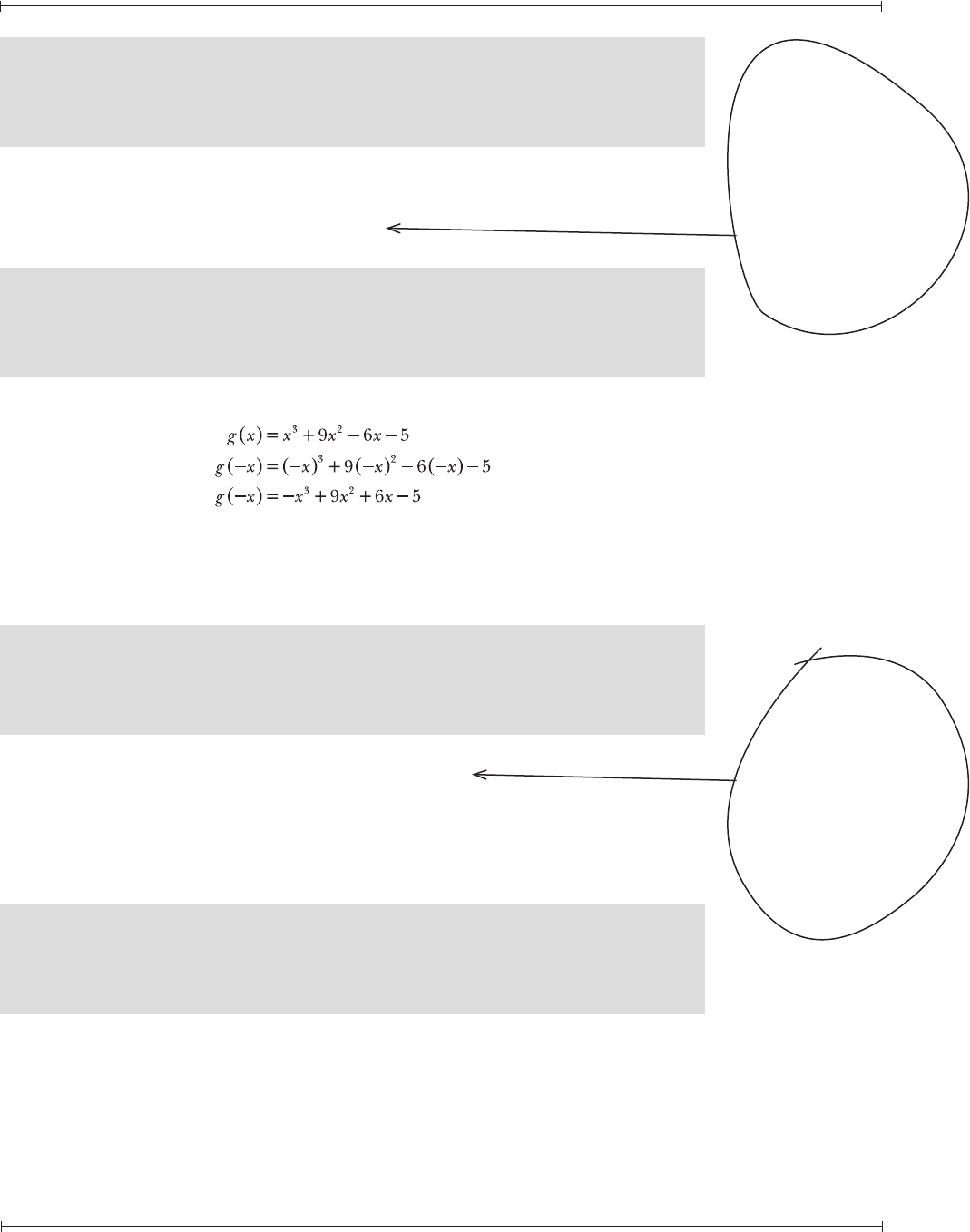
Chapter Seventeen — Calculating Roots of Functions
The Humongous Book of Algebra Problems
388
Descartes’ Rule of Signs
Sign changes help enumerate real roots
21.21 Describe how to apply Descartes’ rule of signs to determine the number of
positive and negative roots of a function.
To predict the number of positive roots of a function f(x), count the number
of times its consecutive terms change sign and then subtract multiples of 2.
For instance, the terms of the function g(x) = 3x
4
+ 5x
3
– 6x
2
+ x – 9
change sign three times, so it either has three positive roots or 1 positive root.
To predict how many negative roots a function has, substitute –x into the
function and count the number of sign changes in f(–x). That number (or an
even integer fewer than that number) represents the total number of negative
roots of f(x).
Note: Problems 17.22–17.23 refer to the function f(x) = x
2
– 7x + 13.
17.22 Apply Descartes’ rule of signs to predict the total number of positive roots
of f(x).
Compare the signs of consecutive terms, working from left to right. Note that
x
2
and –7x have different signs, as do –7x and 13, for a total of two sign changes.
According to Descartes’ rule of signs, f(x) may have two positive roots. However,
f(x) may also have two fewer than that: 2 – 2 = 0. Therefore, f(x) has either two
or zero positive roots.
Note: Problems 17.22–17.23 refer to the function f(x) = x
2
– 7x + 13.
17.23 Apply Descartes’ rule of signs to predict the total number of negative roots of
f(x).
Substitute –x into the function and simplify.
Compare the signs of consecutive terms, working from left to right. The first
pair of terms (x
2
and 7x) have the same sign, as do the final pair of terms (7x
and 13). Because the terms of f(–x) do not change sign, f(x) has no negative
roots.
Go from
left to right:
3x
4
and 5x
3
are
both positive, so no
sign change; 5x
3
and
–6x
2
have different
signs, so 1 sign change
so far; –6x
2
and x have
different signs, so 2
total sign changes;
and x and –9 have
different signs,
so 3 total sign
changes.
This is the
tricky part of
Descartes’ rule of
signs. The number
of sign changes is not
always the number of
roots—it could have 2
fewer than the total, or
2 fewer than that, or 2
fewer than that, and so
on. For example, if some
function j(x) has 6
sign changes, it
could have 6, 4,
2, or 0 roots.
You don’t
have to worry
about saying “or
two fewer than
that, or two fewer
than that, and so on.”
in this case, because
you can’t have
fewer than no
roots!

Chapter Seventeen — Calculating Roots of Functions
The Humongous Book of Algebra Problems
389
Note: Problems 17.24–17.25 refer to the function g(x) = x
3
+ 9x
2
– 6x – 5.
17.24 Apply Descartes’ rule of signs to predict the total number of positive roots of
g(x).
The consecutive terms of g(x) change sign only once as you work from left to
right: x
3
and 9x
2
have the same sign, as do the terms –6x and –5. The only sign
change occurs between the terms 9x
2
and –6x. According to Descartes’ rule of
signs, g(x) has exactly one positive root.
Note: Problems 17.24–17.25 refer to the function g(x) = x
3
+ 9x
2
– 6x – 5.
17.25 Apply Descartes’ rule of signs to predict the total number of negative roots of
g(x).
Identify the function g(–x) and simplify it.
The terms of g(–x) change sign twice (once between –x
3
and 9x
2
and once
between 6x and –5). According to Descartes’ rule of signs, g(x) has either two or
zero negative roots.
Note: Problems 17.26–17.27 refer to the function h(x) = –9x
3
+ 7x
2
+ 2x
5
+ 4 – 4x
4
– 10x.
17.26 Apply Descartes’ rule of signs to predict the total number of positive roots of
h(x).
Before applying Descartes’ rule of signs, rewrite the polynomial so that the
powers of x appear in order, from greatest to least.
h(x) = 2x
5
– 4x
4
– 9x
3
+ 7x
2
– 10x + 4
The function contains four sign changes, so h(x) has either four, two, or zero
roots.
Note: Problems 17.26–17.27 refer to the function h(x) = –9x
3
+ 7x
2
+ 2x
5
+ 4 – 4x
4
– 10x.
17.27 Apply Descartes’ rule of signs to predict the total number of negative roots of
h(x).
As stated in Problem 17.26, the terms must be rewritten so that the powers of x
are in descending order.
h(x) = 2x
5
– 4x
4
– 9x
3
+ 7x
2
– 10x + 4
Again,
you don’t
have to worry
about saying “or
two fewer than that.”
You only have to throw
in the “2 fewer than
that” possibilities when
there are two or
more total sign
changes.
The order
of the terms
affects how many
sign changes there
will be, so make sure
the powers of x are
listed in order, from
the largest to the
smallest.
..................Content has been hidden....................
You can't read the all page of ebook, please click here login for view all page.
